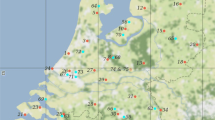Abstract
Daily mean, maximum and minimum surface airtemperature data were gathered from a network ofautomatic weather stations (AWS) within the Moor HouseNational Nature Reserve in northern England. Five AWSwere installed next to the official EnvironmentalChange Network weather station at Moor House. Datawere compared graphically and correction constantswere calculated to adjust data from each AWS to thestandard of the official station by optimising theconcordance correlation coefficient. Each correctedstation was re-located next to one of five in-situstations in and around the reserve, allowingcorrection of all temperature sensors to a commonstandard. The mean error associated with measureddaily mean, maximum and minimum temperature for eachsensor does not exceed ±0.2 K. The procedurequantifies a source of systematic measurement error,improving the identification of spatial temperaturedifferences between stations.
Similar content being viewed by others
References
Beard, G. R., Scott, W. A. and Adamson, J. K.: 1999, ‘The value of consistent methodology in long-term environmental monitoring', Environ. Monit. Assess. 54, 239–258.
Bland, J. M. and Altman, D. G.: 1986, ‘Statistical methods for assessing agreement between two methods of clinical measurement', The Lancet 1, 307–310.
Burt, T. P.:1994, ‘Long term study of the natural environment: perceptive science or mindless monitoring?', Progress in Physical Geography 18, 475–496.
Hulme, M., Conway, D., Jones, P. D., Jiang, T., Barrow, E. M. and Turney, C.: 1995, ‘Construction of a 1961-1990 European climatology for climate-change modeling and impact application', International Journal of Climatology 15, 1333–1363.
Hutchinson, M. F.: 1987, ‘Methods for Generation of Weather Sequences', in A. H. Bunting (ed.), Agricultural Environments: Characterisation, Classification and Mapping, CAB, Wallingford.
Lennon, J. J. and Turner, J. R. G.: 1995, ‘Predicting the spatial distribution of climate: temperature in Great Britain', Journal of Animal Ecology 64, 370–392.
Lin, L.: 1989, ‘A concordance correlation coefficient to evaluate reproducibility', Biometrics 45, 255–268.
Linacre, E.: 1992, Climate Data and Resources, Routledge, London.
Manley, G.: 1942, ‘Meteorological observations on Dun Fell, a mountain station in northern England', Quarterly Journal of the Royal Meteorological Society 68, 151–165.
Steichen, T. J.: 1998, ‘Concordance correlation coefficient', Stata Technical Bulletin 43, 35–39.
Sykes, J. M. and Lane, A. J. M. (eds): 1997, The UK Environmental Change Network: Protocols for Standard Measurements at Terrestrial Sites, Stationary Office, London.
Woodward, F. I.:1987, Climate and Plant Distribution, University Press, Cambridge.
Author information
Authors and Affiliations
Corresponding author
Rights and permissions
About this article
Cite this article
Joyce, A., Adamson, J., Huntley, B. et al. Standardisation of Temperature Observed by Automatic Weather Stations. Environ Monit Assess 68, 127–136 (2001). https://doi.org/10.1023/A:1010795108641
Issue Date:
DOI: https://doi.org/10.1023/A:1010795108641




